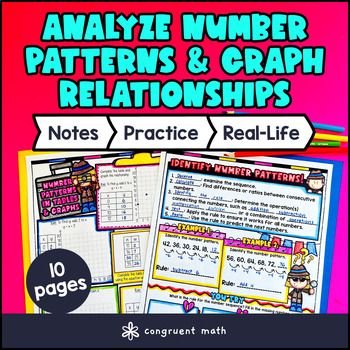Want more ideas and freebies?
Get my free resource library with digital & print activities—plus tips over email.
Join for Free Resources →
$4.25
Ever wondered how to teach number patterns and graphing relationships in an engaging way to your 5th-grade students?
In this lesson plan, students will learn about identifying number patterns in sequences, tables, and graphing ordered pairs on coordinate planes (first quadrant only). Through artistic, interactive guided notes, check for understanding, practice worksheet activities, and a maze, students will gain a comprehensive understanding of number patterns and graphing relationships.
The lesson ends with a real-life example that explores how these math skills can be applied in solving real-world problems. Students will read and write about the real-life uses of number patterns and graphing relationships.

$4.25
After this lesson, students will be able to:
Before this lesson, students should be familiar with:
As a hook, ask students why understanding number patterns and graphing relationships is important in solving real-life problems. Refer to the last page of the guided notes for inspiration on how to frame this question.
Use the first page of the guided notes to introduce the concept of identifying number patterns in sequences. Walk through the key points of identifying patterns in number sequences. Have students practice finding differences or ratios between consecutive numbers.
Continue by using the second page of the guided notes to introduce filling in tables of numerical relationships and graphing ordered pairs on coordinate planes. Model the process of graphing relationships and interpreting the data shown. Ensure students understand how to plot points accurately and connect them to reveal a relationship.
Based on student responses during the introduction, reteach any concepts that students may find challenging or need additional support with. If your class has a mix of proficiency levels, consider grouping students accordingly to provide targeted support and allow more advanced students to begin working on practice exercises.
Have students practice identifying number patterns, filling in tables, and graphing ordered pairs using the practice worksheet (pg. 2) and maze activity (pg. 3) included in the guided notes. Walk around to answer student questions.
Fast finishers begin color by number activity (pg. 4) for extra practice. You can alternatively assign it as homework for the remainder of the class.
Using the last page of the guided notes, bring the class back together, and introduce the concept of identifying number patterns and graphing relationships in real-life scenarios. You can discuss how businesses use data trends to forecast sales or how engineers use patterns to design efficient structures.
Refer to the FAQ section for more ideas on how to teach real-world applications of number patterns and graphing relationships!
If you’re looking for digital practice for Number Patterns & Graphing Relationships, try my Pixel Art activities in Google Sheets. Every answer is automatically checked, and correct answers unlock parts of a mystery picture. It’s incredibly fun, and a powerful tool for differentiation.
Here’s 1 activity to explore:
Number patterns in mathematics refer to sequences of numbers that follow a specific rule or trend. These patterns can help identify relationships between numbers and can be depicted graphically on coordinate planes.
Key points:
Identifying number patterns in a sequence involves recognizing the rule or pattern that governs how the numbers in the sequence are generated or related to each other.
Key points:
Graphing relationships in mathematics involves representing the connections or associations between different sets of data using visual representations like coordinate planes and graphs.
Key points:
To graph ordered pairs on a coordinate plane, you plot points where the x-coordinate represents the horizontal position and the y-coordinate represents the vertical position on the plane.
Key points:
Understanding number patterns and graphing relationships is crucial in mathematics as it helps develop critical thinking skills, pattern recognition abilities, and the capacity to analyze data visually.
Key points:
Students can practice identifying number patterns effectively by engaging in activities that involve recognizing sequences, filling in missing numbers, and extending patterns using tables or graphs.
Key points:
Real-life applications of number patterns and graphing relationships can be found in various fields such as science, finance, art, and computer programming, where recognizing patterns and relationships are essential.
Key points:
Teachers can make learning number patterns and graphing relationships engaging by incorporating hands-on activities, visual aids, interactive games, and real-world examples to connect mathematical concepts with practical applications.
Key points:
Get my free resource library with digital & print activities—plus tips over email.
Join for Free Resources →